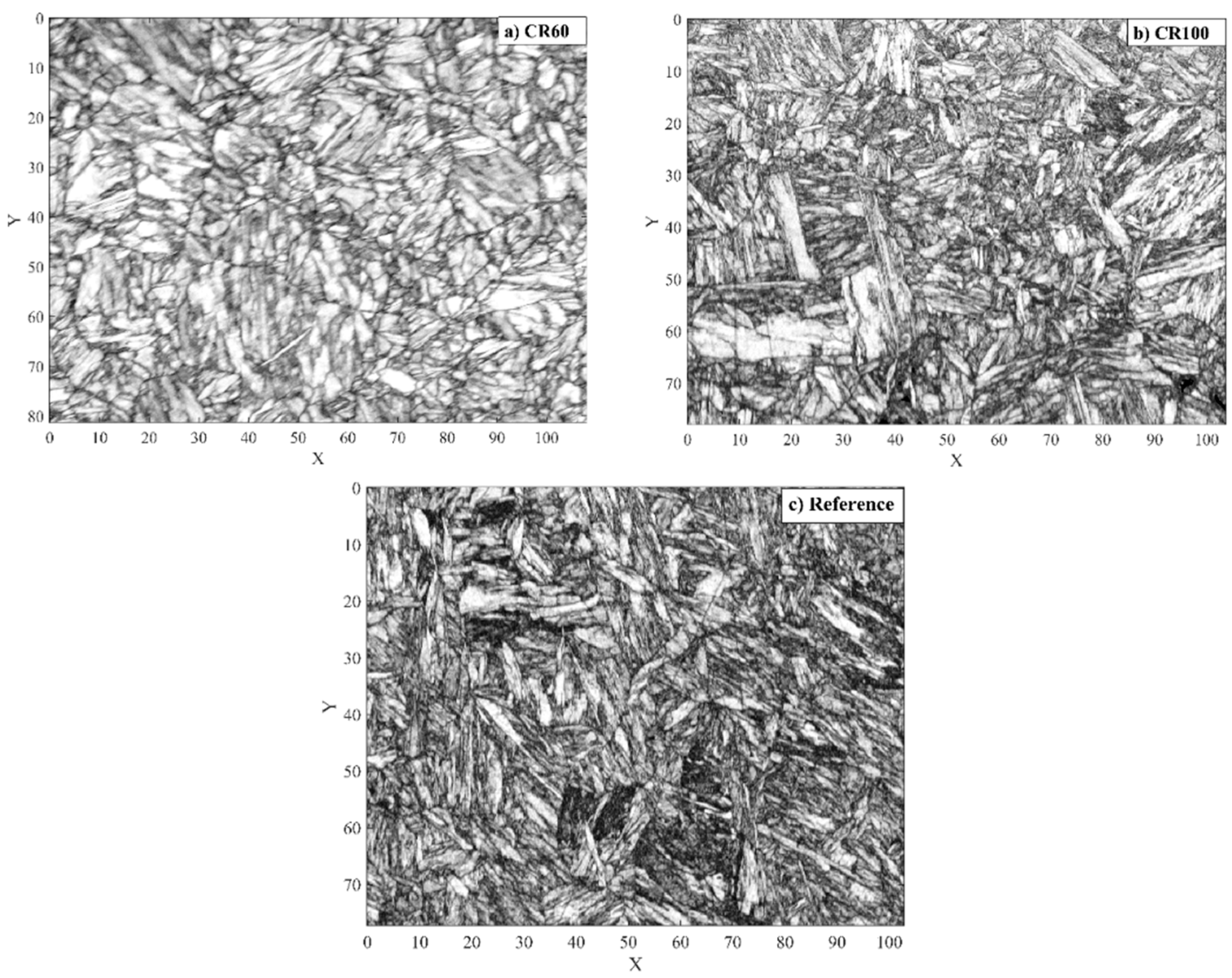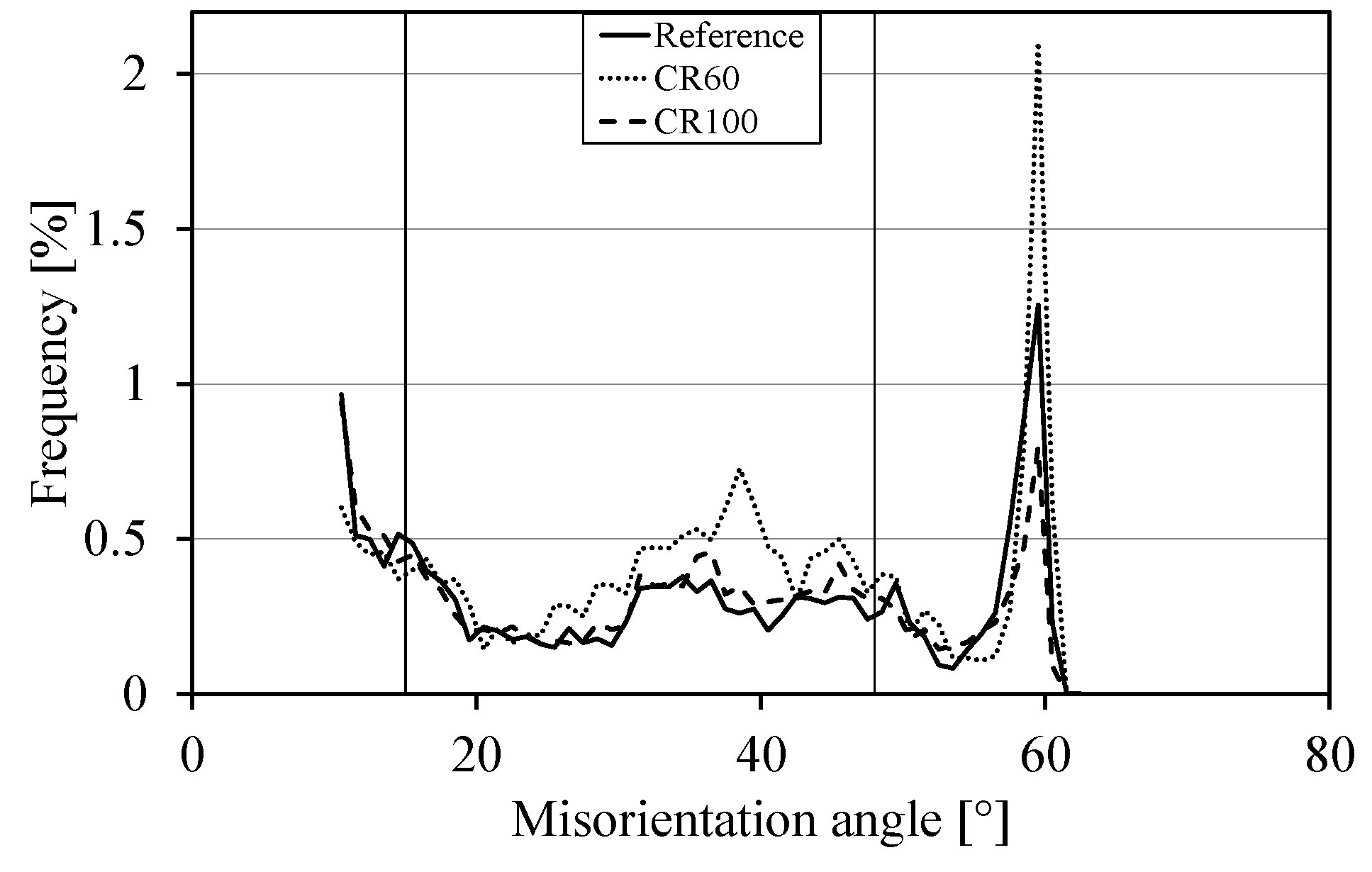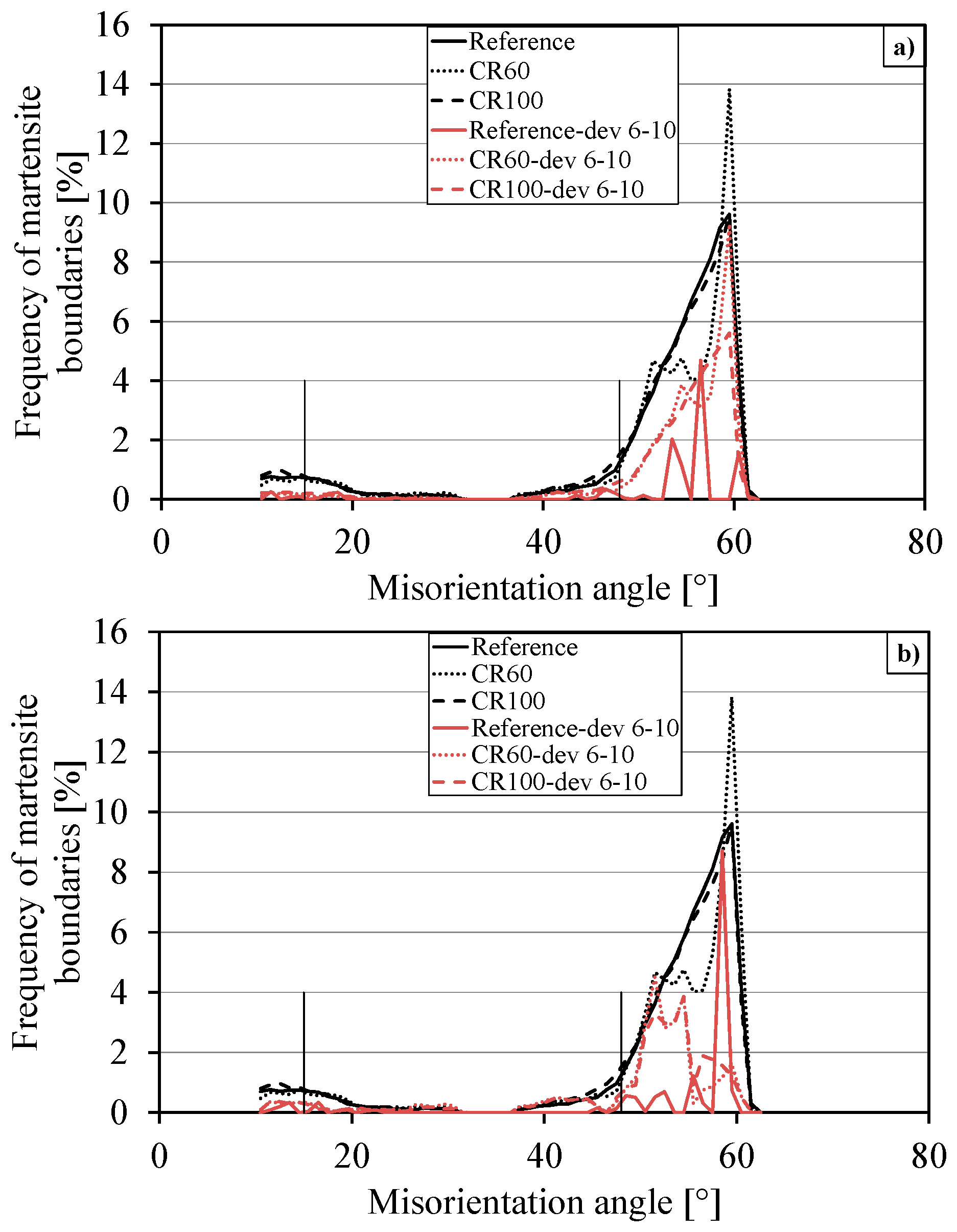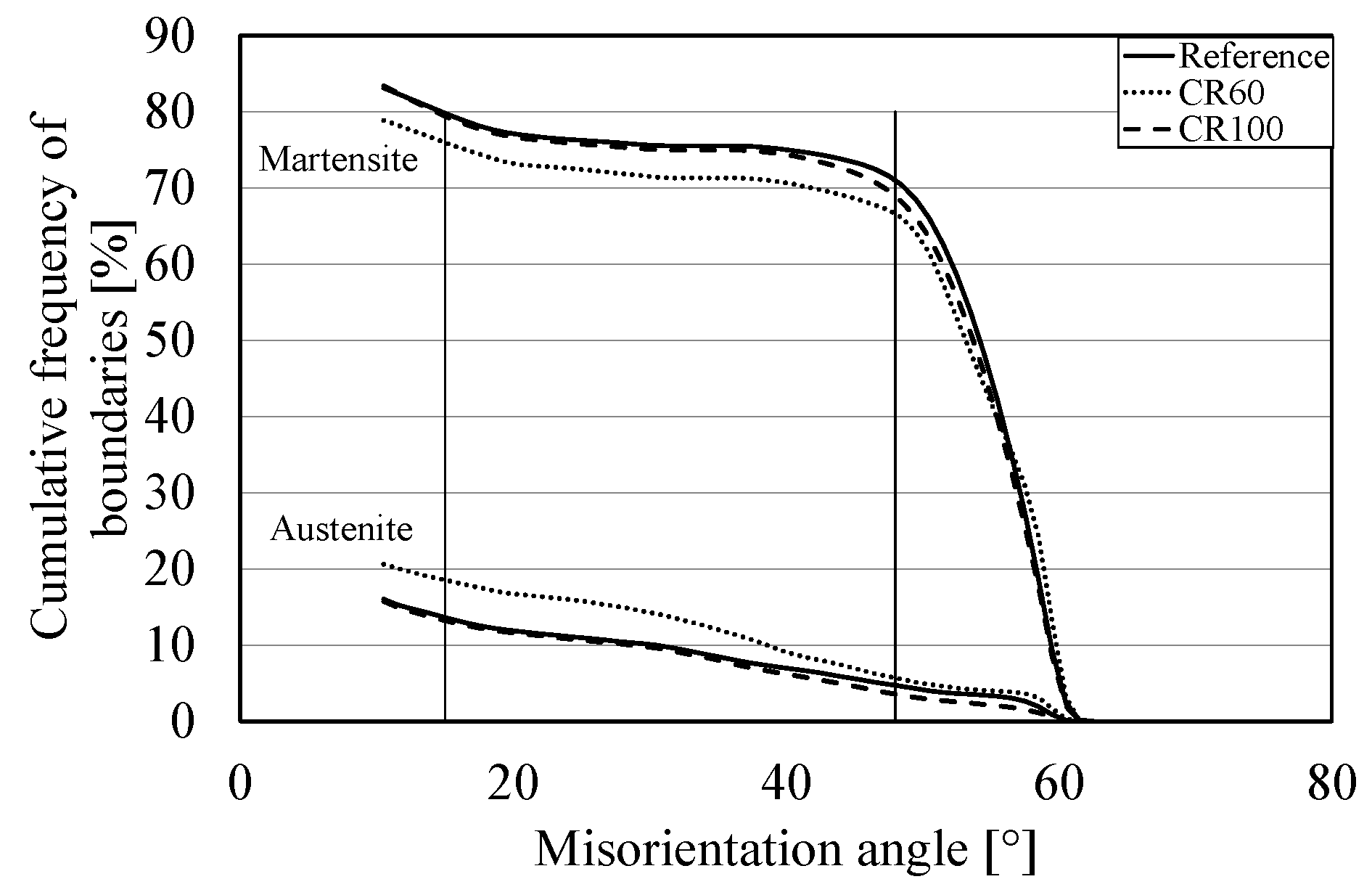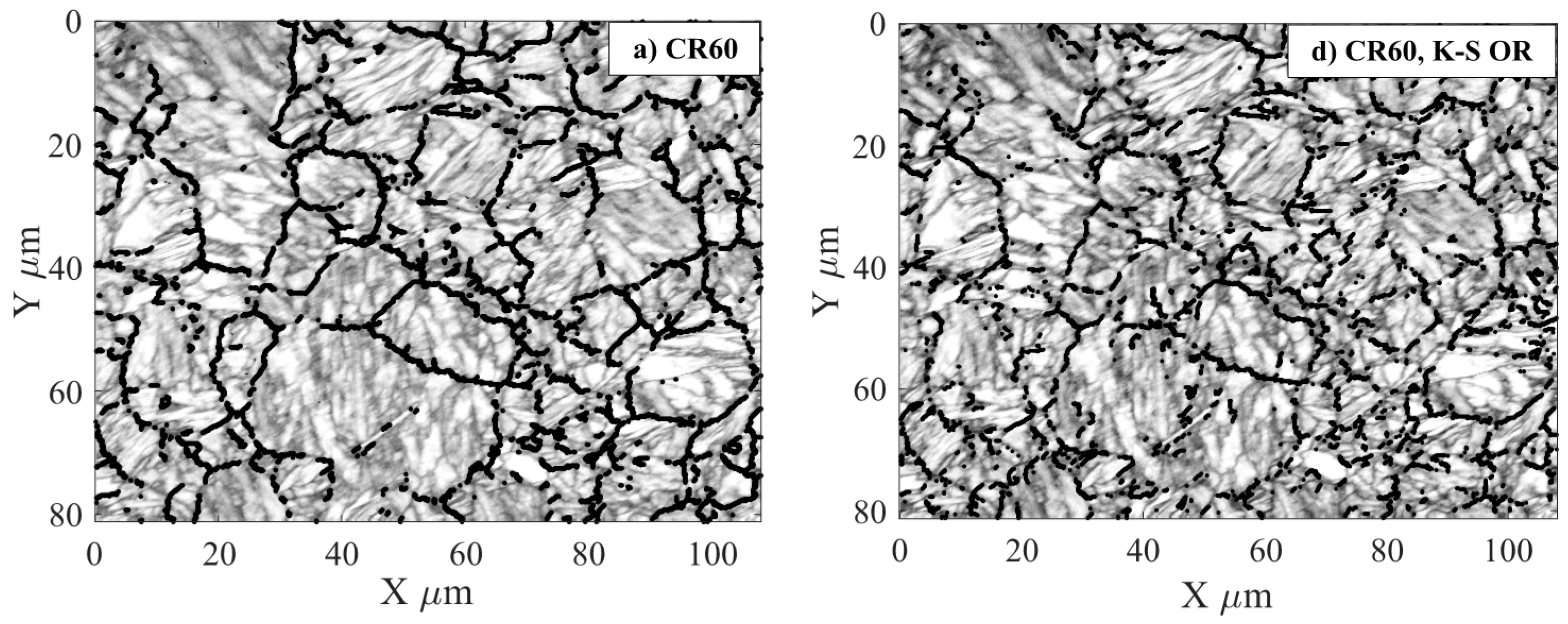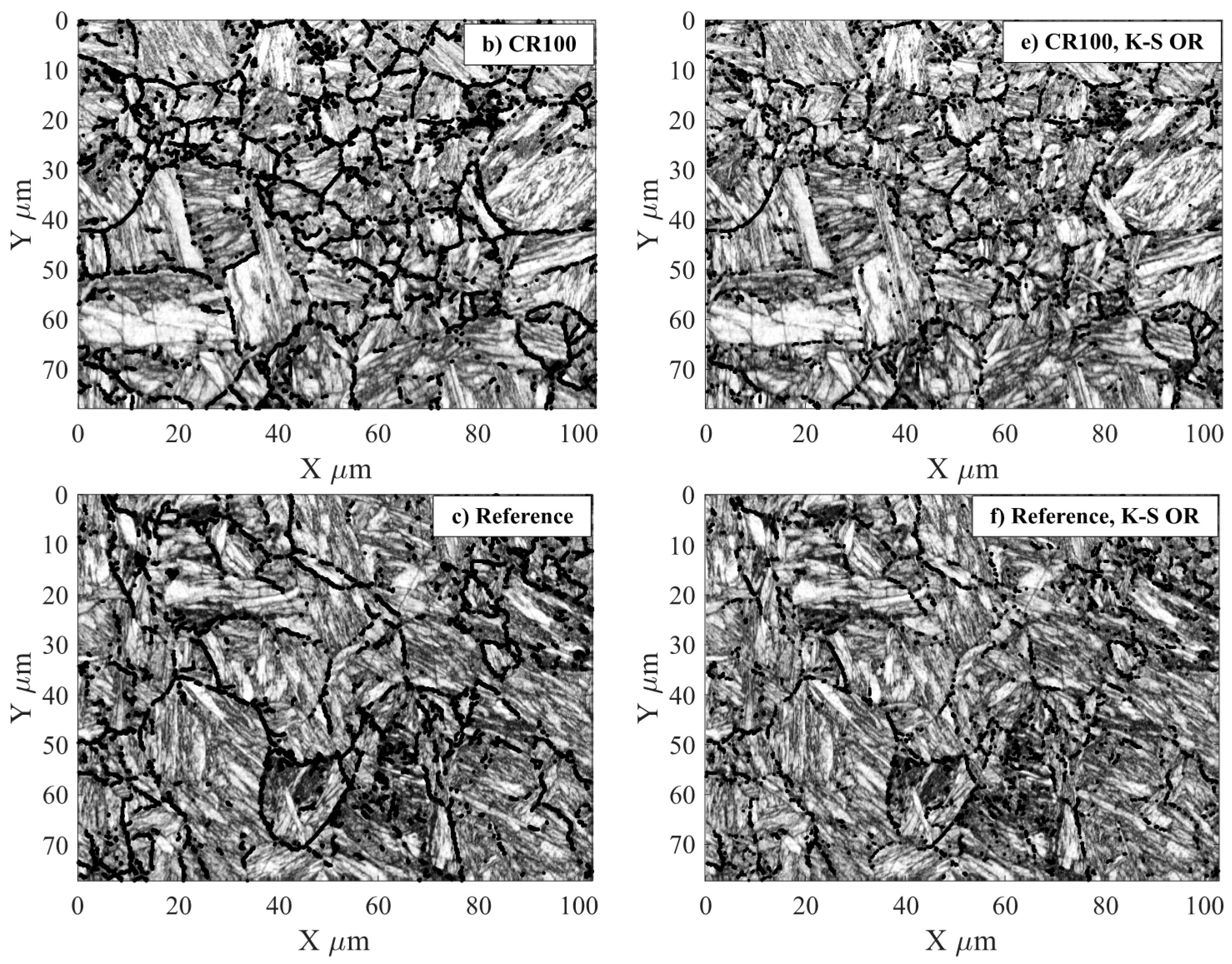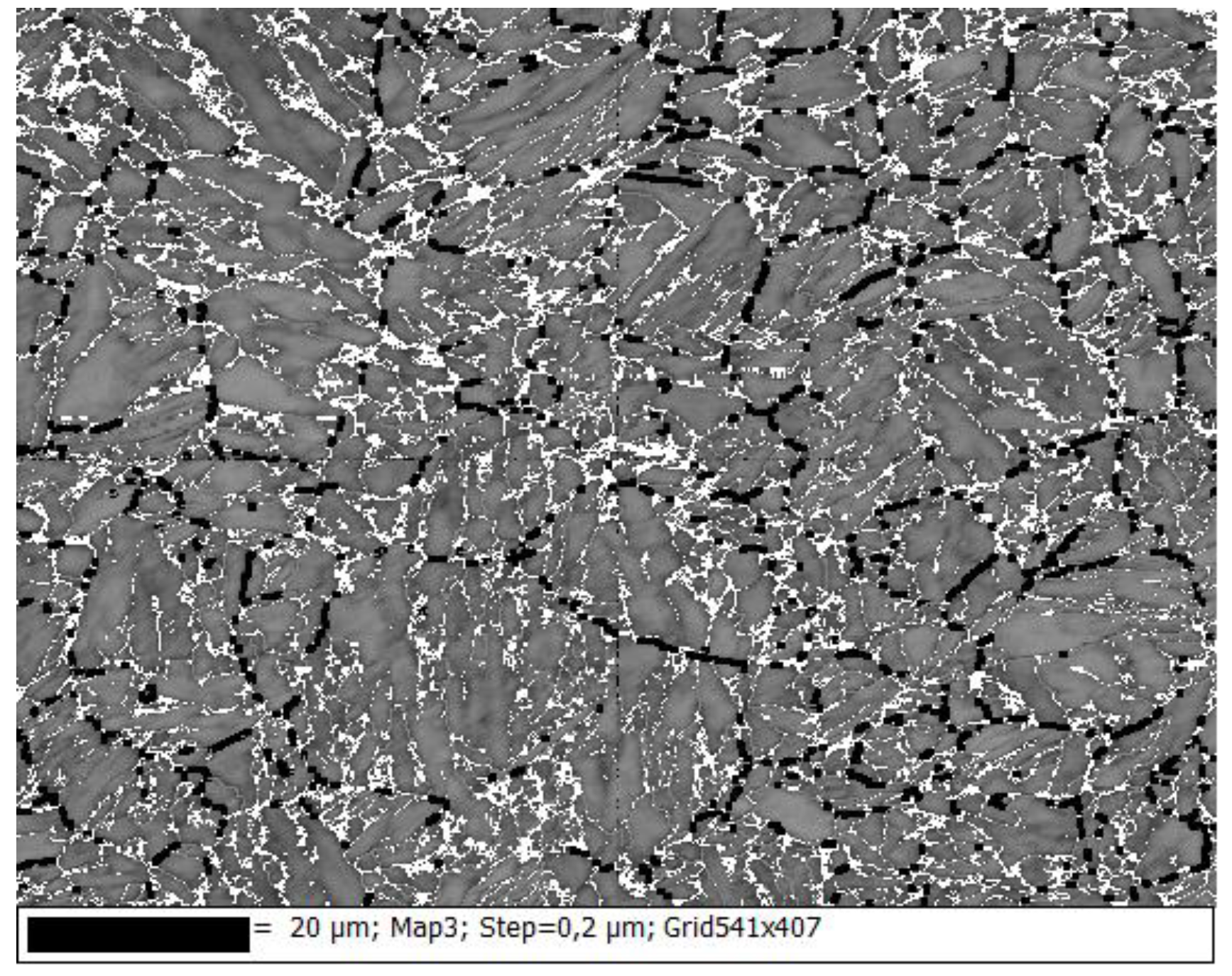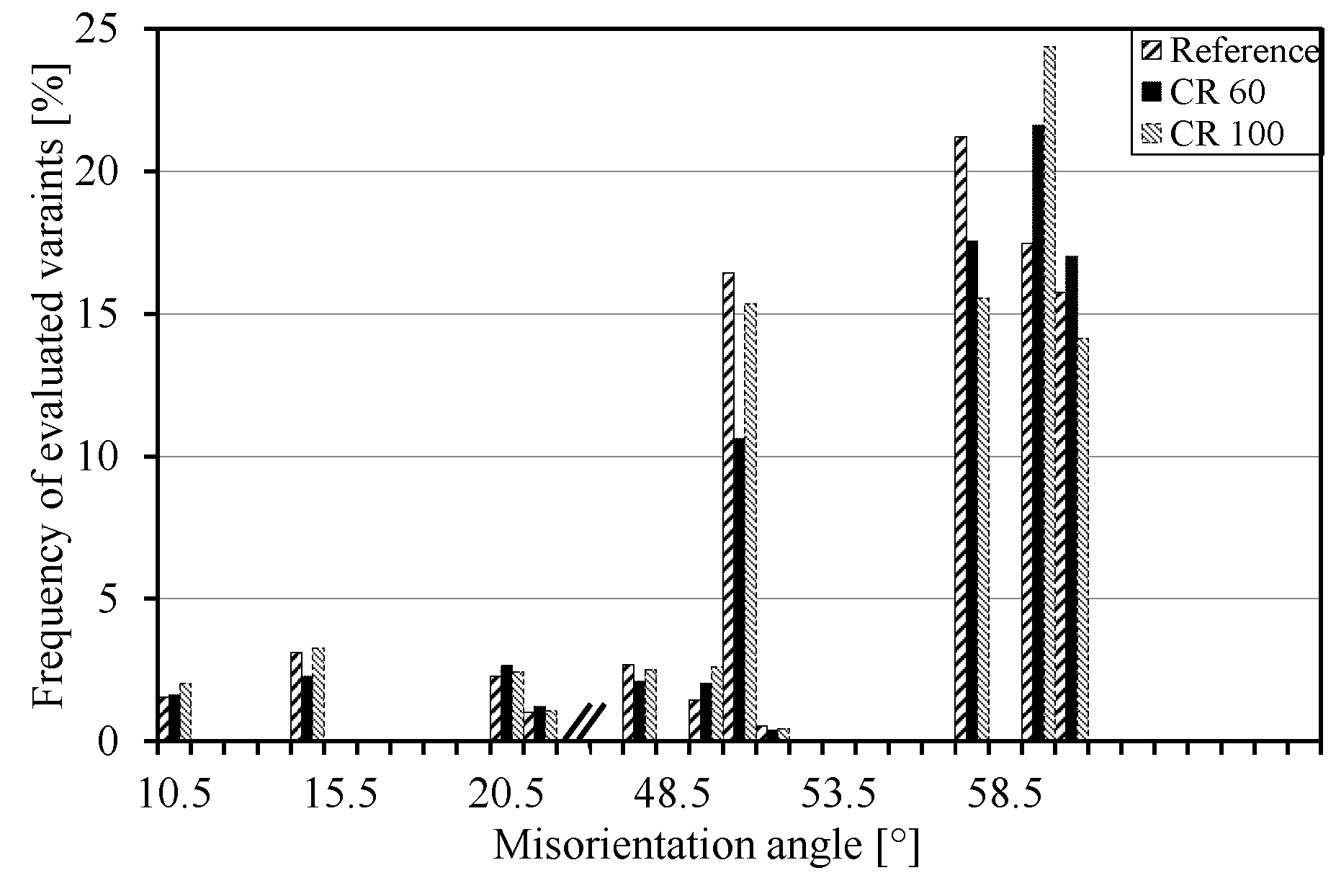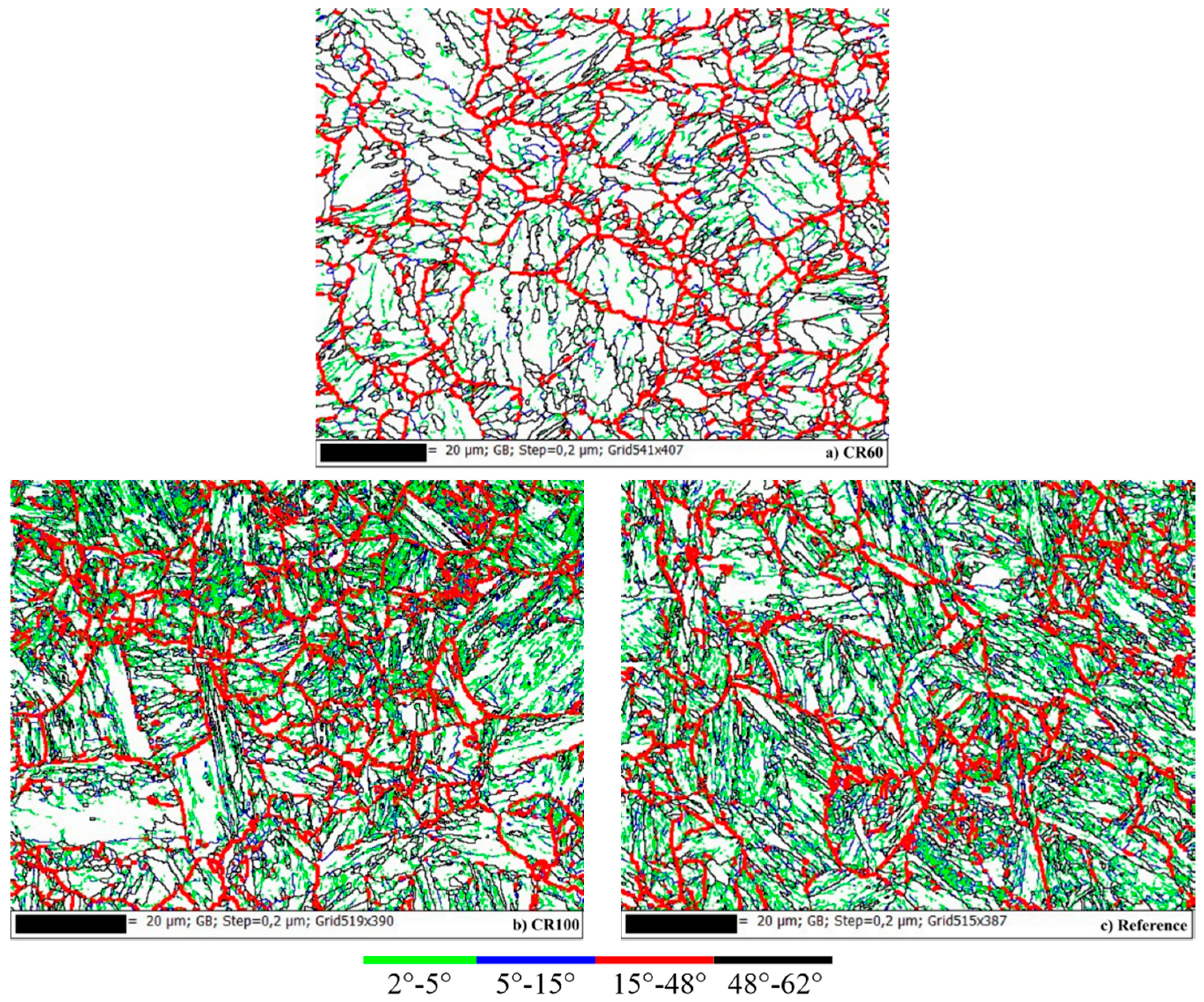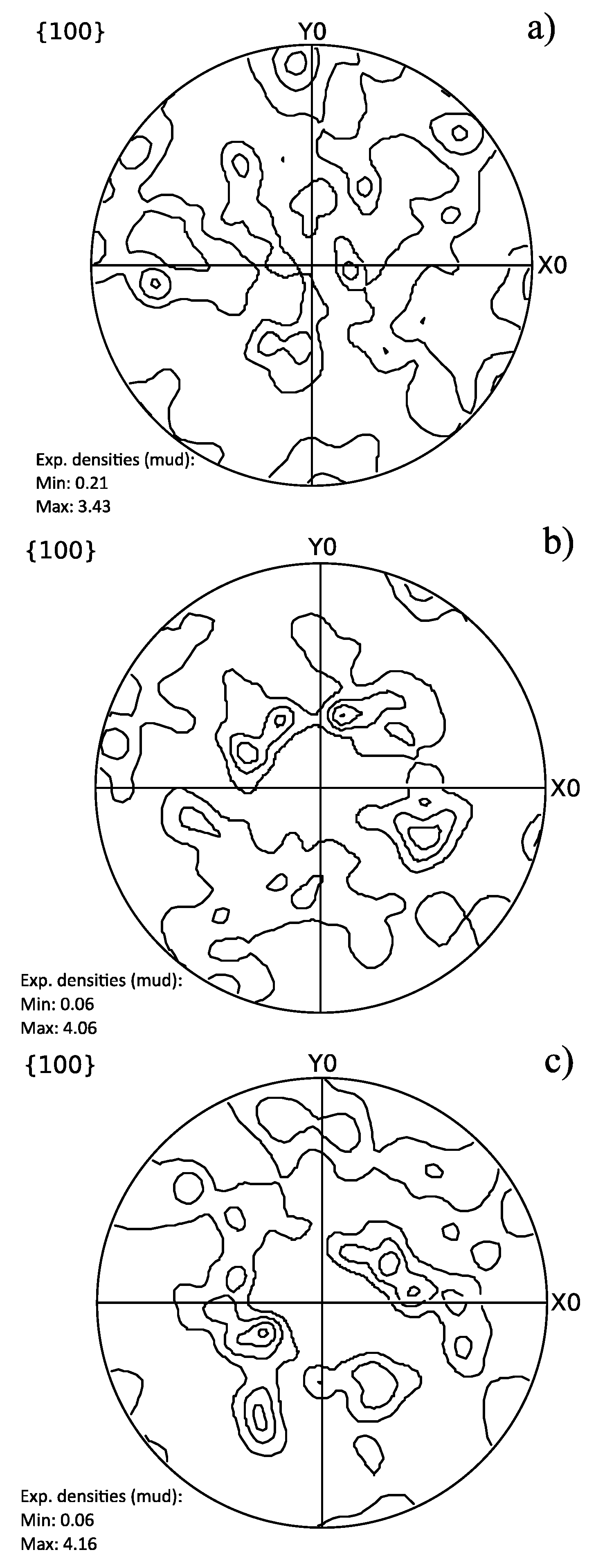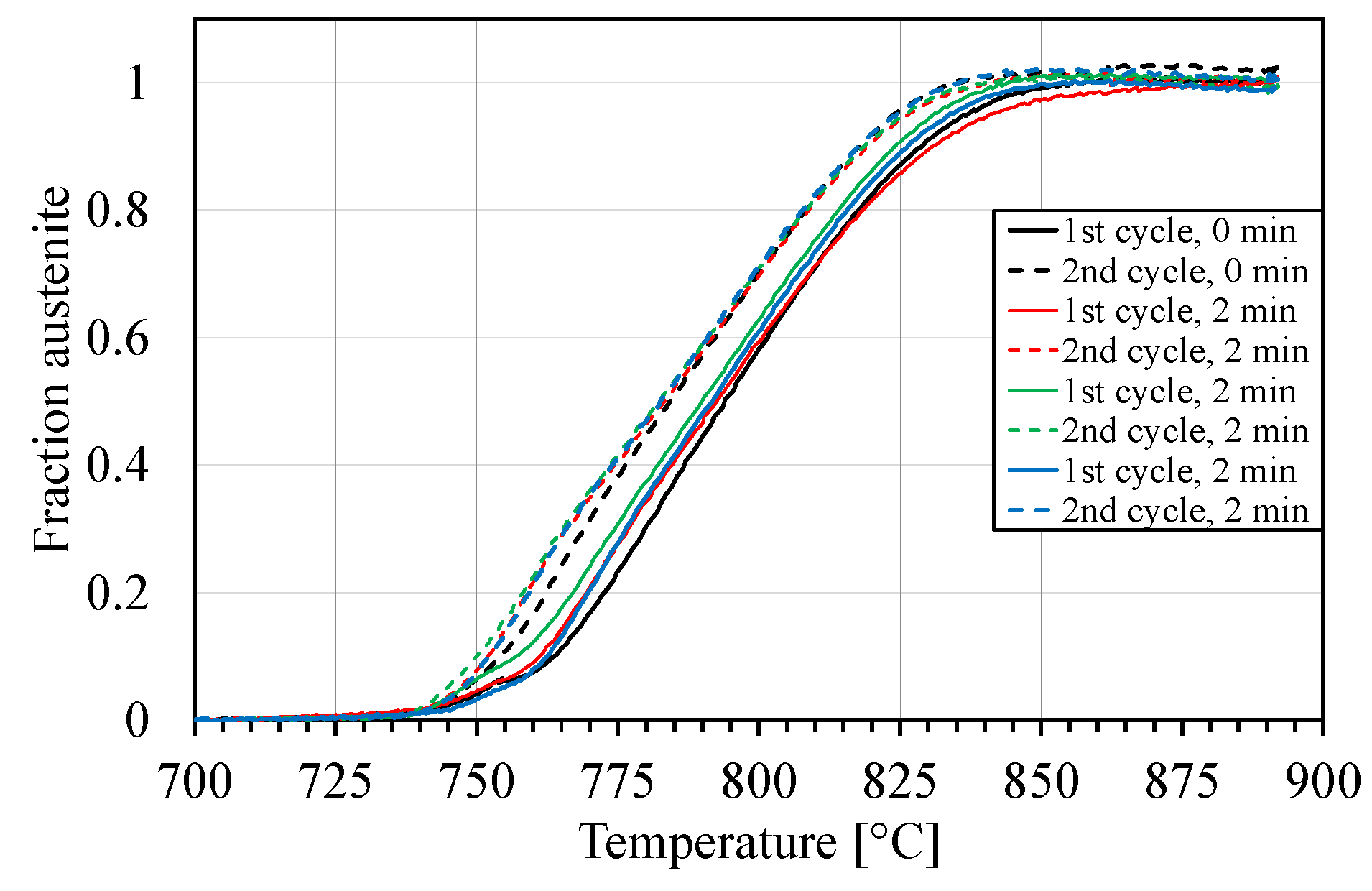1. Introduction
Low alloy wear resistant martensitic steels are widely used in structural applications due to their excellent mechanical properties, especially high strength and wear resistant properties. Some of these steels suffer from flatness problems and residual stresses during hot rolling and quenching in the manufacturing process, which affects the mechanical properties of the end product. For steel producers it is important to have even quality of their steels to ensure reliability to customers. In order to reduce the residual stresses and avoid costly post processing to counter flatness problems, it is important to understand the history of deformation and the microstructure obtained from the manufacturing process [
1]. The final microstructure of these steels after the final processing step in manufacturing is generally martensite and the mechanical properties depends on the microstructure [
2]. In order to understand the martensitic microstructure, it is necessary to understand the prior austenitic morphology. The crystallographic orientation relationship (OR) is maintained when austenite transforms into martensite. This allows investigation of the austenitic phase by reconstruction of the crystallographic OR, which can be used to understand the mechanical properties [
3].
In the present study, martensitic steel samples of Hardox 450 both as-received from the manufacturing process and dilatometry samples are characterized by way of electron backscatter diffraction (EBSD) and micro hardness measurements. The main aims of the investigation are to determine the austenite grain size and shape using EBSD data, with an algorithm to find the parent austenite grain boundaries, in order to understand the hardness results of a reference sample and two dilatometry samples. Thus, austenite grain size affects the size of martensite crystals and the size of parallel arrays of martensite crystals, and thereby affects the strength of hardened microstructures [
4]. Subsequently, this study is to correlate the nearest cooling rate by a dilatometer which yields a similar orientation relationship and substructure as the reference sample. This knowledge will improve further experimental setup, modelling, and simulation of the hardening process.
Martensite is a hard phase in steels which forms when the steel is cooled rapidly from the austenitic region. Martensitic microstructures can also be generated by plastic deformation [
5], for example, in metastable austenitic steels [
3]. There are two types of martensite that can form, one is the cubic α’ which is a semi-coherent phase and the other is the hexagonal ε which is a coherent phase. The type of martensite depends on the transformation, the carbon content, and the stacking fault energy [
6]. The formation of martensite in steels occurs via a diffusionless transformation which means that the carbon content within the crystal is trapped in octahedral sites of a body-centred cubic structure (bcc) [
3]. The super-saturated carbon content affects the distortion of the new lattice and the crystal’s tetragonality [
3]. Increasing carbon content will result in more tetragonality due to the high occupancy of carbon in the interstitial sites [
7]. Carbon content also affects the martensitic microstructure that can develop in ferrous α’ martensitic bcc or body-centred tetragonal (bct) structures, i.e., lath-, lenticular plate-, thin plate-, and butterfly- martensites [
8,
9]. These martensitic transformations can be distinguished by morphology, kinetics, crystallography, or internal structure [
6].
During martensitic transformation, the austenite crystals experience straining represented by a volume change as well as shear which changes the crystal structure. The already transformed martensitic crystals strain the remaining adjacent austenite crystals due to the increased volume of the harder martensite. Thus, the austenite experiences elastic and plastic deformation. The interface connecting the martensite with the austenite must have high mobility and therefore will move with high velocities during rapid quenching [
3]. The phase boundary is either coherent or semi coherent, and an OR exists between the martensite and parent austenite phase. The OR is maintained by lattice distortions which results in the formation of dislocation cells or deformation twins, which reduce the system’s energy [
10].
The OR between adjacent crystals in solid state is important in order to understand the material’s mechanical properties. Reproducible OR between the parent and product phases determines the morphology of martensite by reducing the interface energy and creating the best fit between the crystals. The OR usually consists of parallel or very nearly parallel corresponding closest packed planes from the two lattices, and it is usually the case that the corresponding close packed directions in these planes are also roughly parallel [
3].
Many OR models have been developed for the austenite to martensite transformation, but the most commonly used are the Kurdjumov-Sachs (K-S), Nishiyama-Wasserman (N-W), Greninger-Troiano (G-T), and Bain OR models.
Table 1 shows the planes and directions for the OR for these four models [
11]. Gungunes et al. [
12] found that austenite and thermally induced martensite usually have an OR of the Kurdjumov-Sachs type.
Lath martensite has a three-level hierarchy in its morphology, which is laths, blocks, and packets. For the K-S OR, 24 possible equivalent crystallographic variants can be possibly formed within a grain and six variants in a packet. However, Kitahara et al. [
13] found that all variants do not appear in a grain. In sub-blocks, specific combinations of two variants appeared and this indicates a strict rule for variant selection. Variant selection is the result of shape deformation of a martensite lath/plate that may or may not comply with an external stress. The compliance of a variant and applied stress can be described by an interaction energy [
14]. Positive interaction energy for a variant, which is in the plane subjected to an applied stress, means that the variant is favoured. Kundu et al. [
15] showed that the position and space constraint in the microstructure might play a role in deciding which variants that will form regardless of their interaction energy. It is important to remember that the austenite almost always is constrained during quenching due to internal stresses because of temperature gradients in the material.
A martensite lath is a single martensite crystal. Lath boundaries usually have a misorientation of 2°–5°. Martensite laths (variants) with a similar crystal orientation pair up and build blocks [
16]. The pairs are built by V1 and one of the variants from V2 to V6 (see
Table 2), and the border between the pairs is the block boundary. Packets may consist of several blocks with slightly different orientations but the same habit plane [
16]. Packet boundaries can have misorientation angles in both low-angle and high-angle intervals [
17]. The effective grain structures which control deformation are the block and packet structures, because of the largely common crystallographic orientation of the parallel component laths within the blocks and packets [
18]. When packet size decreases, the strength of low-carbon steels increases and affects the toughness of the martensitic steel [
19].
Polycrystalline materials with a random distribution of grain orientations require that at least five independent strains can be achieved for two grains to be deformed without decohesion between the grains. Therefore, it requires at least five independent slip systems in each grain of a polycrystalline material. The five independent slip systems that result in the highest Schmid factors of the grain are used to calculate the Taylor factor m, as the inverted mean value [
20].
In the custom build model, the Taylor factor was calculated for each pixel and a mean value for all were calculated. The slip systems used in the calculations were {10−1} <111> and {11−2} <111>. In bcc-metals there are usually many favourable glide systems which cause the Taylor factor to be close to the lowest value, which is two when all planes and directions are possible slip systems. This means that there are always several glide systems that have close to the maximum resolved shear stress. If the material has strong texture, the Taylor factor becomes dependent on the orientation, just as for a single crystal [
20].
2. Materials and Methods
2.1. Method
The custom build Matlab™ (Mathworks, Natick, USA) model was used to calculate the local disorientation, which is the smallest misorientation angle for a common rotation axis, using the crystallographic orientation obtained by EBSD. The mean value of the disorientation to the left and below each pixel is the local disorientation. The evaluation method is based on the K-S OR between the parent austenite crystal and the daughter martensite. High angle grain boundaries (HAGB) have been evaluated for angles above 10° and low angle grain boundaries for disorientation angles above 2°.
Conditions for a martensite boundary is established on the basis of misorientation and the boundary must be considered as a parent austenite grain boundary when the condition is not fulfilled.
The martensite boundary here is defined as the boundary between the martensite variants of one parent austenite grain. The other boundaries, which do not fulfil the conditions, are boundaries between martensite laths of two different parent austenite grains and they are therefore considered as parent austenite grain boundaries.
The 24 possible variants of martensite orientation given by K-S OR for a single austenite grain result in 276 possible combinations of variants with corresponding misorientation angles and rotation axes between adjacent martensite crystals.
All HAGBs were then compared to the possible misorientation angles and the corresponding rotation axes, and they were considered as martensite boundaries if they agreed within ±10 degrees. The rest of the boundaries were considered to be parent austenite grain boundaries according to the EBSD analysis.
The results for the misorientation angle and misorientation axis in this work, shown in
Table 2, are compared with the results of Kitahara et al. [
13]. These specific misorientations are between martensite variants of one parent austenite grain. Therefore the parent austenite grain boundaries can be determined by searching for the boundaries between martensites with misorientations which are different from those specific values.
2.2. Material
The samples were taken from the abrasion resistant steel, Hardox 450 (a trade name from SSAB, Sweden) for the present study. These steels generally have a fully martensitic structure after hot rolling and quenching with a unique combination of high hardness and high strength with excellent impact toughness.
The slab, of 220 mm thickness, is heated to about 1250 °C before entering the hot rolling mill, where it is rolled to a strip with 6 mm thickness. When the strip reaches the finishing mill its temperature is about 1000 °C and the exit temperature of the strip is 890 °C. The reduction in this finishing mill begins at 30% and reduces to 12% at the exit. The material is fully recrystallized at the exit. The lowest recrystallization temperature is approximated to be 884 °C from the equation developed by Barbosa et al. [
21]. However, this equation involves the influence of micro alloying elements, which however are not present in Hardox 450, and which can impede recrystallization [
22]. The strip is then water quenched in the cooling section.
The chemical composition of these samples is shown in
Table 3. A reference sample was taken from the final coiled product which had undergone hot rolling and quenching. Samples from Hardox 450, manufactured in the same way as the reference sample, have been subjected to various cooling rates by use of dilatometry.
2.3. Dilatometry and Micro Hardness
The dilatometric experiments were performed in a quenching dilatometer DIL 805A from TA instruments (New Castle, DE, USA). The samples were 4 mm diameter cylinders with 10 mm length that had been cut from the centre of the strip’s width of a 6 mm thick Hardox 450 strip in the rolling direction. The surfaces were parallel and flat. The samples were first heated to 890 °C at 10 °C/s and then austenitised for 2 min with subsequent cooling to room temperature. The cooling rates used were 60 °C/s and 100 °C/s. The samples will hereafter be called CR60, CR100, and reference. The CR60 and CR100 samples were chosen for EBSD analysis due to the formation of fully martensitic structures.
To elucidate the effect of carbide formation during cooling and the state of the reference sample, dilatometry tests were performed in two cycles using the same heating and cooling as for CR100. Six samples were subjected to cyclic testing. Three of them had no hold time at room temperature (RT) and the others had 2 min hold time at RT.
Micro Vickers hardness measurements were performed on the reference sample and the dilatometry samples using a Matsuzawa MXT 50 (Akita Prefecture, Akita, Japan) automatic digital micro hardness tester with 500 g load.
2.4. EBSD-Analysis
The EBSD measurements were performed using a field emission gun Zeiss Ultra 55 scanning electron microscope (Carl Zeiss Microscopy, Jena, Germany). Data acquisition and post-processing of crystalline data were performed using HKL Channel 5 software (version 5.12.61.0, Oxford Instrument NanoAnalysis, Oxford, UK). The step size used for each sample was 0.2 μm. The area for EBSD analyses was chosen to be 100 μm wide and about 80 μm high, and the surfaces were normal to the rolling direction and in the vicinity of the centre of the specimen.
4. Conclusions
The low alloyed wear resistant steel shows fully martensitic microstructures in both reference and dilatometry samples.
One main difference between the reference sample and the dilatometry samples are the amount of existing carbides, which affects the hardness. The reference sample and CR100 have a similar distorted microstructure, fine substructure, and crystallographic texture, while CR60 has a coarser microstructure which also contributes to a lower hardness. The dilatometry sample CR60 shows a less distorted misorientation distribution in the area where the majority of martensite boundaries are observed. The EBSD images also show coarser substructure in this sample as compared to the other two.
The reconstruction of parent austenite grain boundaries with K-S OR between martensite and austenite shows that the dilatometry sample cooled with 100 °C/s is almost identical to the reference sample when it comes to the different types of HAGB (≥10° of misorientation).
The data from the EBSD measurements are evaluated using the K-S OR. The frequency of evaluated parent austenite boundaries for respective samples is most frequent between 15° and 48°. The comparison between different misorientation angles shows that 15°–48° yields the most logical visual image of the parent austenite grains for Hardox 450. The reference sample and CR100 reveal similar misorientation patterns, which also means that the two have similar parent austenite grain structure.
The reconstructed parent austenite grain boundaries in the reference sample showed no significant flattening due to rolling, thus implying a fully recrystallized structure before quenching. Similar austenite grain sizes (HAGB) were observed in all samples. The substructure in CR100 and the reference sample were of equal size with respect to low angle grain boundaries.
The main aims of this study were to determine the austenite grain size and shape, and also to understand the hardness results of the reference sample and the dilatometry samples. This has been accomplished. Also, this study has correlated the nearest cooling rate by the dilatometer which yields similar OR and the substructure as the reference sample. This work contributes to knowledge about the correlation between the austenitic structure, martensitic structure, and the conditions after quenching.
